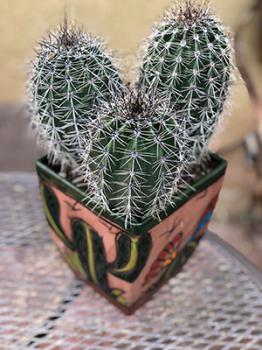December 14, 2019
Saguaros in New Mexico

Question:
Is this a saguaro in my front yard in Las Cruces? I’ve heard that saguaros do not grow well in this area. I planted it in 2012 and it is growing about 1 foot each year. It’s currently close to 6 feet tall.
- Mike B., Las Cruces
Answer:
Yes, probably, but maybe not.
When we talk about saguaros in the Southwest, we’re referring to the Arizona saguaro (Carnegiea gigantea) of the Sonoran Desert. But there’s also an Argentine saguaro or cordon grande (Trichocereus terscheckii, aka Echinopsis terscheckii) that looks remarkably similar and is known to be one of the cold-hardiest columnar cacti in the world, rated at USDA cold hardiness zone 8 (average annual extreme low temperatures reaching 10–20°F).

The Sonoran saguaro is rated at USDA cold hardiness zone 9, withstanding extreme low temperatures of 20–30°F. Las Cruces and surrounding areas are generally regarded as being in USDA hardiness zone 8 (same as the Argentine saguaro). However, the most recent USDA Cold Hardiness Zone Map was published in 2012 and used average cold temperature data from the 30-year period from 1976–2005. It’s possible that average extreme cold temperatures over the last 30 years would push Las Cruces up a zone or at least a half zone. Master’s graduate student Scott Miller is working with his advisor Dr. Carol Campbell in the NMSU geography department and myself to update hardiness zone maps for New Mexico and predict cold hardiness zones in the coming decades, so stay tuned on the cold front.
Of course, microclimates become extra important when we’re worried about reaching minimum temperatures that plants can tolerate. It’s likely that the saguaro in your yard grew so fast and survived so long because it’s tucked up close to the south-facing stucco wall in your yard and surrounded at the base by large heat-radiating rocks. I suspect that yours is a Sonoran saguaro, so on nights when temperatures in your area are expected to drop down to the low 20s or below, I’d consider protecting it. You can wrap it with an old blanket, put up a big umbrella like they use at farmers’ markets to shelter it, place a 5-gallon container of warm water nearby to radiate a small amount of heat, or all of the above. Be careful, you know what I say: Here today, gone saguaro!
I remember seeing saguaros around Las Cruces over the years, and I happened to be down there recently, so I took the opportunity to ask around and then hunt down a few saguaros for this week’s column. Together with a friend, we photographed nine saguaros in total. Some of them are the Sonoran saguaro, some are Argentine, and one was made of wood. For photos of all of them, visit the Desert Blooms blog and search “saguaro.”

I learned that there are a few key differences to help differentiate between the Sonoran and Argentine saguaros. Sonoran saguaros are known to grow extremely slowly compared to Argentine ones, especially in the first decades. One source stated that a 10-year-old Sonoran saguaro may only be 1.5 inches tall. That made me think yours could be an Argentine. But upon closer look, there are more than 20 spines (glochids) at each cluster (areole), and that is indicative of it being a Sonoran saguaro. Besides having fewer glochids per areole, glochids on Argentine saguaros are more of a yellow-orange color and tend to be longer. Argentine saguaros often develop their arm-like stems at a much younger age and closer to the ground than Sonoran saguaros.
Absolute plant identification often requires observation of the flower, so be sure to share a flowering photo if you ever catch it blooming! I found one blooming at a gas station in San Simon, Arizona on October 6th. The attendant said it had just started blooming the night before. One of the other differences between these two saguaros is bloom time. Sonoran saguaros are expected to bloom in late spring, while the Argentine saguaro is said to bloom any time between April and October. I checked back at the pictures I took of the flowers and, sure enough (#okbloomer), the spines sure do look like it’s an Argentine. For a video of these pretty flowers, check out the blog (link above).
Thanks to the following who helped with my saguaro-seeking mission: City of Las Cruces Community Forester Jimmy Zabriskie, NMSU Assistant Professor/Lecturer of Horticulture Rachel Gioannini, Las Cruces Gardening Resource Facebook group members Lucas Herndon and Raena Cota, Doña Ana County Extension Horticulture Agent Jeff Anderson, BLM Las Cruces District Botanist Dr. Patrick Alexander, Santa Ana Native Plant Nursery Manager Mike Halverson, and Las Cruceñas Connie Chapman and Elizabeth Schutte.

Marisa Y. Thompson, PhD, is the Extension Horticulture Specialist, in the Department of Extension Plant Sciences at the New Mexico State University Los Lunas Agricultural Science Center, email: desertblooms@nmsu.edu, office: 505-865-7340, ext. 113.
Links:
For more gardening information, visit the NMSU Extension Horticulture page at Desert Blooms and the NMSU Horticulture Publications page.
Send gardening questions to Southwest Yard and Garden - Attn: Dr. Marisa Thompson at desertblooms@nmsu.edu, or at the Desert Blooms Facebook page.
Please copy your County Extension Agent and indicate your county of residence when you submit your question!